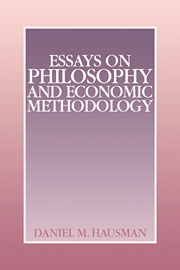Book contents
- Frontmatter
- Contents
- Introduction: What is philosophy of economics?
- PART I METHODOLOGY AND THEORY APPRAISAL
- PART II CAUSALITY IN ECONOMICS
- PART III CASES AND PUZZLES
- 12 What are general equilibrium theories?
- 13 Arbitrage arguments
- 14 Explanatory progress in economics
- 15 On dogmatism in economics: the case of preference reversals
- PART IV POSTSCRIPTS
- Bibliography of relevant writings by Daniel M. Hausman
- Bibliography of works by other authors
- Index
15 - On dogmatism in economics: the case of preference reversals
Published online by Cambridge University Press: 05 June 2012
- Frontmatter
- Contents
- Introduction: What is philosophy of economics?
- PART I METHODOLOGY AND THEORY APPRAISAL
- PART II CAUSALITY IN ECONOMICS
- PART III CASES AND PUZZLES
- 12 What are general equilibrium theories?
- 13 Arbitrage arguments
- 14 Explanatory progress in economics
- 15 On dogmatism in economics: the case of preference reversals
- PART IV POSTSCRIPTS
- Bibliography of relevant writings by Daniel M. Hausman
- Bibliography of works by other authors
- Index
Summary
Standard economic theory incorporates a simple definition or model of rationality. An agent A chooses rationally if A's preferences are complete and transitive and if there is no feasible option that A prefers to the one A chooses. A's preferences are complete if for all options x and y either A prefers x to y or A prefers y to x or A is indifferent between x and y. A's preferences are transitive if for all options x, y, and z, if A prefers x to y and y to z, then A prefers x to z and similarly for indifference. Insofar as economic theory attempts to describe, explain, or predict how people actually behave, economists do more than merely define what rationality is. They must in addition maintain that people are to some degree of approximation rational – that is, to some degree of approximation, that the preferences of real people are complete and transitive and that real people choose what they most prefer. These generalizations about preference and choice are called “utility theory,” and they play an important role in statistics, decision theory, and even philosophy, as well as in economics.
No one is under any illusion that these generalizations are exceptionless universal laws. Faced with a long series of choices among pairs of options, most of us would probably eventually violate transitivity. Given the reality of ignorance, people may often be unable to rank alternatives at all.
- Type
- Chapter
- Information
- Essays on Philosophy and Economic Methodology , pp. 200 - 218Publisher: Cambridge University PressPrint publication year: 1992



